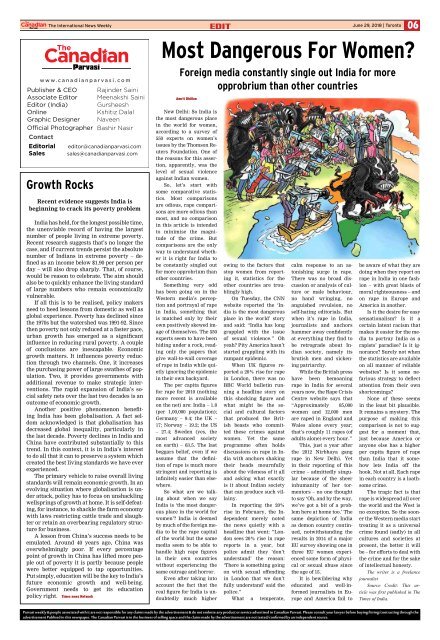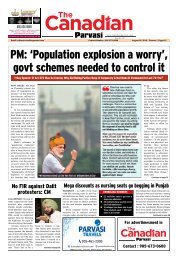The Canadian Parvasi-issue 52
You also want an ePaper? Increase the reach of your titles
YUMPU automatically turns print PDFs into web optimized ePapers that Google loves.
EDIT<br />
<strong>The</strong> International News Weekly June 29, 2018 | Toronto 06<br />
<strong>The</strong><br />
w w w . canadianparv asi. c o m<br />
Publisher & CEO<br />
Associate Editor<br />
Editor (India)<br />
Online<br />
Graphic Designer<br />
Official Photographer<br />
Contact<br />
Editorial<br />
Sales<br />
Growth Rocks<br />
Rajinder Saini<br />
Meenakshi Saini<br />
Gursheesh<br />
Kshitiz Dalal<br />
Naveen<br />
Bashir Nasir<br />
editor@canadianparvasi.com<br />
sales@canadianparvasi.com<br />
Recent evidence suggests India is<br />
beginning to crack its poverty problem<br />
India has held, for the longest possible time,<br />
the unenviable record of having the largest<br />
number of people living in extreme poverty.<br />
Recent research suggests that’s no longer the<br />
case, and if current trends persist the absolute<br />
number of Indians in extreme poverty – defined<br />
as an income below $1.90 per person per<br />
day – will also drop sharply. That, of course,<br />
would be reason to celebrate. <strong>The</strong> aim should<br />
also be to quickly enhance the living standard<br />
of large numbers who remain economically<br />
vulnerable.<br />
If all this is to be realised, policy makers<br />
need to heed lessons from domestic as well as<br />
global experience. Poverty has declined since<br />
the 1970s but the watershed was 1991-92. Since<br />
then poverty not only reduced at a faster pace,<br />
urban growth has emerged as a significant<br />
influence in reducing rural poverty. A couple<br />
of conclusions are inescapable. Economic<br />
growth matters. It influences poverty reduction<br />
through two channels. One, it increases<br />
the purchasing power of large swathes of population.<br />
Two, it provides governments with<br />
additional revenue to make strategic interventions.<br />
<strong>The</strong> rapid expansion of India’s social<br />
safety nets over the last two decades is an<br />
outcome of economic growth.<br />
Another positive phenomenon benefiting<br />
India has been globalisation. A fact seldom<br />
acknowledged is that globalisation has<br />
decreased global inequality, particularly in<br />
the last decade. Poverty declines in India and<br />
China have contributed substantially to this<br />
trend. In this context, it is in India’s interest<br />
to do all that it can to preserve a system which<br />
created the best living standards we have ever<br />
experienced.<br />
<strong>The</strong> primary vehicle to raise overall living<br />
standards will remain economic growth. In an<br />
evolving situation where globalisation is under<br />
attack, policy has to focus on unshackling<br />
wellsprings of growth at home. It is self-defeating,<br />
for instance, to shackle the farm economy<br />
with laws restricting cattle trade and slaughter<br />
or retain an overbearing regulatory structure<br />
for business.<br />
A lesson from China’s success needs to be<br />
emulated. Around 40 years ago, China was<br />
overwhelmingly poor. If every percentage<br />
point of growth in China has lifted more people<br />
out of poverty it is partly because people<br />
were better equipped to tap opportunities.<br />
Put simply, education will be the key to India’s<br />
future economic growth and well-being.<br />
Government needs to get its education<br />
policy right. Times news Network<br />
Most Dangerous For Women?<br />
Foreign media constantly single out India for more<br />
opprobrium than other countries<br />
Amrit Dhillon<br />
New Delhi: So India is<br />
the most dangerous place<br />
in the world for women,<br />
according to a survey of<br />
550 experts on women’s<br />
<strong>issue</strong>s by the Thomson Reuters<br />
Foundation. One of<br />
the reasons for this assertion,<br />
apparently, was the<br />
level of sexual violence<br />
against Indian women.<br />
So, let’s start with<br />
some comparative statistics.<br />
Most comparisons<br />
are odious, rape comparisons<br />
are more odious than<br />
most, and no comparison<br />
in this article is intended<br />
to minimise the magnitude<br />
of the crime. But<br />
comparisons are the only<br />
way to understand whether<br />
it is right for India to<br />
be constantly singled out<br />
for more opprobrium than<br />
other countries.<br />
Something very odd<br />
has been going on in the<br />
Western media’s perception<br />
and portrayal of rape<br />
in India, something that<br />
is matched only by their<br />
own positively skewed image<br />
of themselves. <strong>The</strong> 550<br />
experts seem to have been<br />
hiding under a rock, reading<br />
only the papers that<br />
give wall-to-wall coverage<br />
of rape in India while quietly<br />
ignoring the epidemic<br />
in their own backyard.<br />
<strong>The</strong> per capita figures<br />
for rape for 2010 (nothing<br />
more recent is available<br />
on the net) are: India – 1.8<br />
(per 1,00,000 population);<br />
Germany – 9.4; the UK –<br />
17; Norway – 19.2; the US<br />
– 27.4; Sweden (yes, the<br />
most advanced society<br />
on earth) – 63.5. <strong>The</strong> last<br />
beggars belief, even if we<br />
assume that the definition<br />
of rape is much more<br />
stringent and reporting is<br />
infinitely easier than elsewhere.<br />
So what are we talking<br />
about when we say<br />
India is ‘the most dangerous<br />
place in the world for<br />
women’? India is deemed<br />
by much of the foreign media<br />
to be the rape capital<br />
of the world but the same<br />
media seem to be able to<br />
handle high rape figures<br />
in their own countries<br />
without experiencing the<br />
same outrage and horror.<br />
Even after taking into<br />
account the fact that the<br />
real figure for India is undoubtedly<br />
much higher<br />
owing to the factors that<br />
stop women from reporting<br />
it, statistics for the<br />
other countries are troublingly<br />
high.<br />
On Tuesday, the CNN<br />
website reported the ‘India<br />
is the most dangerous<br />
place in the world’ story<br />
and said: “India has long<br />
grappled with the <strong>issue</strong><br />
of sexual violence.” Oh<br />
yeah? Pity America hasn’t<br />
started grappling with its<br />
rampant epidemic.<br />
When UK figures reported<br />
a 20% rise for rape<br />
in London, there was no<br />
BBC World bulletin running<br />
a headline story on<br />
this shocking figure and<br />
what might be the social<br />
and cultural factors<br />
that produced the British<br />
beasts who committed<br />
these crimes against<br />
women. Yet the same<br />
programme often holds<br />
discussions on rape in India<br />
with anchors shaking<br />
their heads mournfully<br />
about the vileness of it all<br />
and asking what exactly<br />
is it about Indian society<br />
that can produce such villainy.<br />
In reporting the 20%<br />
rise in February, the Independent<br />
merely noted<br />
the news quietly with a<br />
headline that went: “London<br />
sees 20% rise in rape<br />
reports in a year, but<br />
police admit they ‘don’t<br />
understand’ the reason:<br />
‘<strong>The</strong>re is something going<br />
on with sexual offending<br />
in London that we don’t<br />
fully understand’ said the<br />
police.”<br />
What a temperate,<br />
calm response to an astonishing<br />
surge in rape.<br />
<strong>The</strong>re was no broad discussion<br />
or analysis of culture<br />
or male behaviour,<br />
no hand wringing, no<br />
anguished revulsion, no<br />
self-hating editorials. But<br />
when it’s rape in India,<br />
journalists and anchors<br />
hammer away confidently<br />
at everything they find to<br />
be retrograde about Indian<br />
society, namely its<br />
brutish men and sickening<br />
patriarchy.<br />
While the British press<br />
have been bemoaning<br />
rape in India for several<br />
years now, the Rape Crisis<br />
Centre website says that<br />
“Approximately 85,000<br />
women and 12,000 men<br />
are raped in England and<br />
Wales alone every year;<br />
that’s roughly 11 rapes (of<br />
adults alone) every hour.”<br />
This, just a year after<br />
the 2012 Nirbhaya gang<br />
rape in New Delhi. Yet<br />
in their reporting of this<br />
crime – admittedly singular<br />
because of the sheer<br />
inhumanity of her tormentors<br />
– no one thought<br />
to say ‘Oh, and by the way,<br />
we’ve got a bit of a problem<br />
here at home too.’ <strong>The</strong><br />
same depiction of India<br />
as demon country continued,<br />
notwithstanding the<br />
results in 2014 of a major<br />
EU survey showing one in<br />
three EU women experienced<br />
some form of physical<br />
or sexual abuse since<br />
the age of 15.<br />
It is bewildering why<br />
educated and well-informed<br />
journalists in Europe<br />
and America fail to<br />
be aware of what they are<br />
doing when they report on<br />
rape in India in one fashion<br />
– with great blasts of<br />
moral righteousness – and<br />
on rape in Europe and<br />
America in another.<br />
Is it the desire for easy<br />
sensationalism? Is it a<br />
certain latent racism that<br />
makes it easier for the media<br />
to portray India as a<br />
rapists’ paradise? Is it ignorance?<br />
Surely not when<br />
the statistics are available<br />
on all manner of reliable<br />
websites? Is it some nefarious<br />
strategy to deflect<br />
attention from their own<br />
shortcomings?<br />
None of these seems<br />
in the least bit plausible.<br />
It remains a mystery. <strong>The</strong><br />
purpose of making this<br />
comparison is not to suggest<br />
for a moment that,<br />
just because America or<br />
anyone else has a higher<br />
per capita figure of rape<br />
than India that it somehow<br />
lets India off the<br />
hook. Not at all. Each rape<br />
in each country is a loathsome<br />
crime.<br />
<strong>The</strong> tragic fact is that<br />
rape is widespread all over<br />
the world and the West is<br />
no exception. So the sooner<br />
the Western media start<br />
treating it as a universal<br />
crime found (sadly) in all<br />
cultures and societies at<br />
present, the better it will<br />
be – for efforts to deal with<br />
the crime and for the sake<br />
of intellectual honesty.<br />
<strong>The</strong> writer is a freelance<br />
journalist<br />
Source Credit: This article<br />
was first published in <strong>The</strong><br />
Times of India.<br />
<strong>Parvasi</strong> weekly & people associated with it are not responsible for any claims made by the advertisement & do not endorse any product or service advertised in <strong>Canadian</strong> <strong>Parvasi</strong>. Please consult your lawyer before buying/hiring/contracting through the<br />
advertisement Publised in this newspaper. <strong>The</strong> <strong>Canadian</strong> <strong>Parvasi</strong> is in the business of selling space and the clains made by the advertisement are not tested/confirmed by an independent source.

















